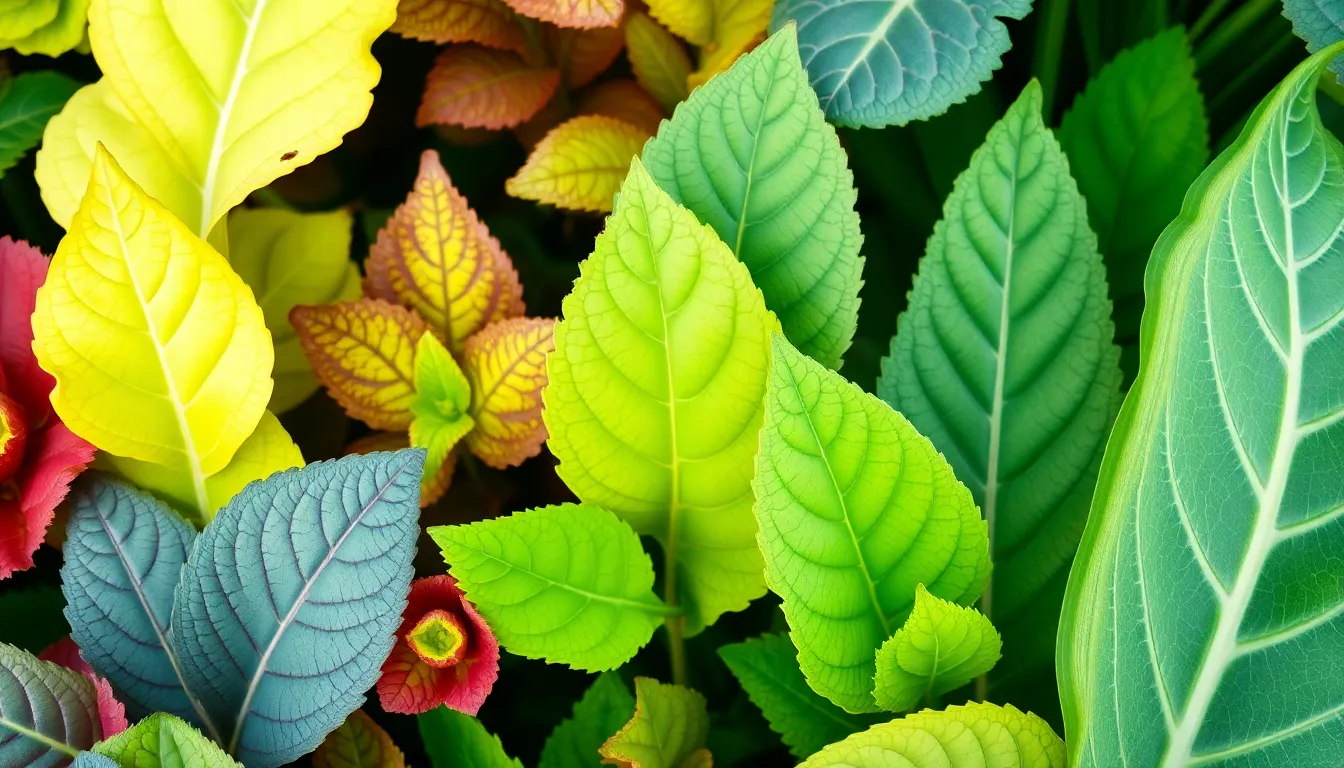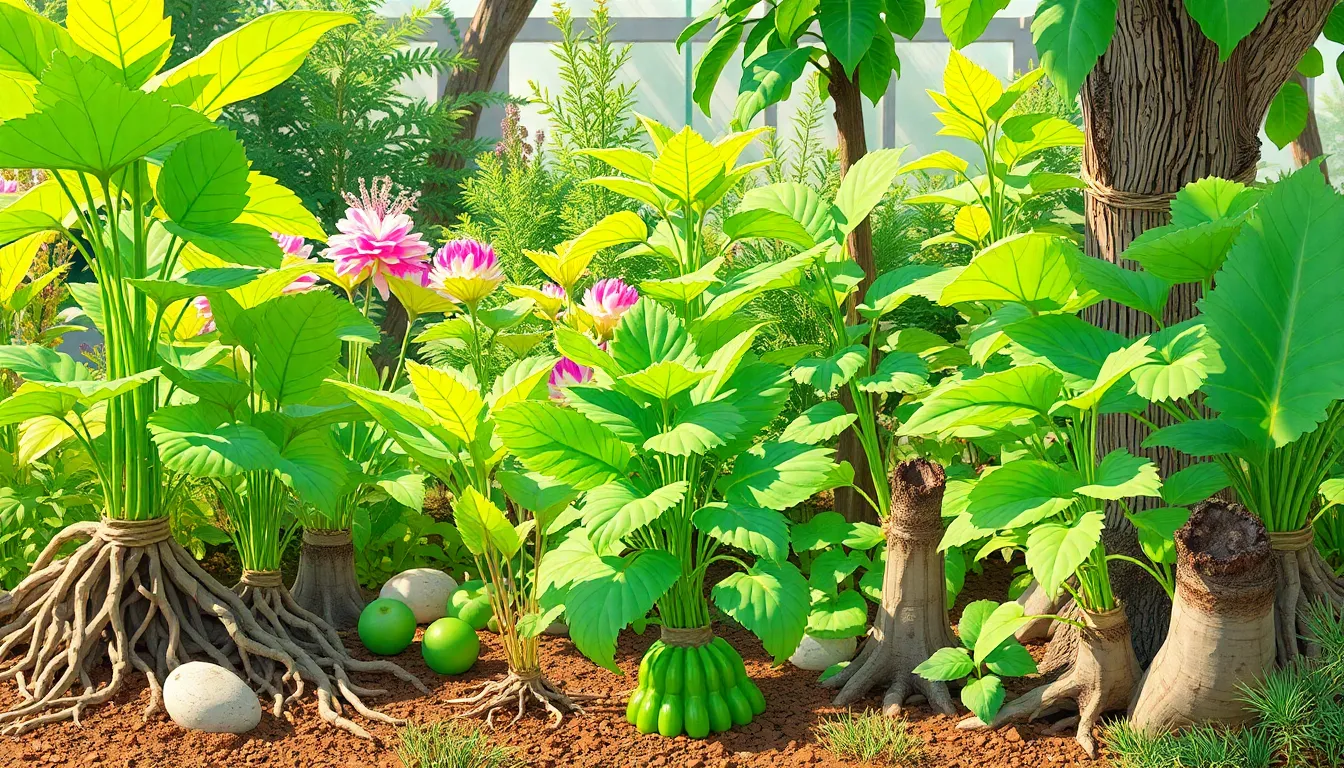Characteristics of Plants: Discover the Surprising Secrets of Nature’s Green Wonders

Plants are the unsung heroes of the planet, quietly working their magic while we hustle through our busy lives. They’re not just pretty faces in the garden; they come with a whole toolbox of characteristics that make them unique and essential. From their ability to photosynthesize like pros to their impressive range of shapes and sizes, plants hold secrets that can leave anyone in awe.
Characteristics Of Plants
Plants exhibit unique features that define their existence and functionality. They utilize photosynthesis to convert sunlight into energy, a process crucial for growth and survival. Structures such as leaves serve multiple purposes, including maximizing sunlight absorption and facilitating gas exchange.
Roots anchor plants in the soil and absorb water and nutrients, supporting their development. Stems provide structural support, transport nutrients, and connect various plant parts. Different species show diverse adaptations based on their environments.
Reproductive strategies also vary among plants. Some rely on seeds, while others reproduce through spores or vegetative propagation. Fleshy fruits attract animals, aiding in seed dispersal. In contrast, wind-pollinated plants often exhibit lighter pollen for easier distribution.
Plants display significant variations in morphology. Leaf shapes, sizes, and arrangements reflect adaptations to local climates and habitats. For example, broad leaves captivate sunlight in shaded areas, while needle-like leaves minimize water loss in arid conditions.
Interaction with their environment defines their growth patterns. Some species thrive in full sunlight, while others prefer shaded areas. Types of soil also influence plant characteristics, as some plants require well-drained soils, whereas others flourish in wet conditions.
These characteristics contribute to their vital role in ecosystems. They offer habitat for numerous organisms, enhance soil health, and participate in nutrient cycling. Understanding these features adds depth to appreciation of plant life and its overarching impact on the planet.
Structural Characteristics

Structural characteristics define how plants grow and function in their environments. Key components include roots, stems, and leaves, each playing a vital role.
Roots
Roots anchor plants securely in the soil. They absorb water and nutrients, ensuring plants have the necessary resources for growth. Some roots store energy, while others facilitate symbiotic relationships with fungi. Taproots penetrate deep into the ground, reaching moisture supplies, whereas fibrous roots cover a wider area for nutrient uptake. This variety allows plants to adapt to diverse soil conditions.
Stems
Stems support the plant structure, creating a framework that holds leaves and flowers. They transport water, nutrients, and sugars between roots and leaves through specialized vascular tissues. Some stems store energy, while others develop into various forms, like woody trunks or herbaceous shoots. The thickness and rigidity of stems provide stability, making them crucial for taller plants to withstand environmental factors like wind.
Leaves
Leaves are the primary sites for photosynthesis, converting sunlight into energy. Their broad surfaces maximize light capture while tiny openings, or stomata, regulate gas exchange. Leaf structures exhibit incredible diversity, with shapes and sizes adapted to specific environments. Some leaves are thick and fleshy, designed for water retention, while others are thin and delicate, optimizing light absorption. Leaf arrangement on stems also influences light exposure and airflow, enhancing overall efficiency.
Functional Characteristics
Plants exhibit essential functional characteristics that contribute to their survival and overall role within ecosystems. They carry out critical processes, such as photosynthesis and reproduction, facilitating growth and perpetuation of their species.
Photosynthesis
Photosynthesis serves as a pivotal process for plants. It occurs primarily in leaves, where chlorophyll captures sunlight. This conversion of light energy into chemical energy creates glucose, which fuels growth and development. Carbon dioxide and water, absorbed through stomata and roots, respectively, are essential raw materials for this process. Oxygen, a byproduct of photosynthesis, is released into the atmosphere, supporting animal life. Plants adapt leaf structure and orientation to optimize light capture, influencing photosynthetic efficiency significantly.
Reproduction
Reproductive strategies among plants vary greatly, showcasing their adaptability. Many plants reproduce through seeds, which develop from flowers after pollination. Some use spores as a means to spread, especially non-flowering varieties like ferns. Additionally, vegetative propagation allows certain plants to reproduce asexually by forming new individuals from roots or stems. These diverse methods ensure plants can thrive in varied environments despite challenges, such as limited pollinators or harsh conditions. Overall, reproductive characteristics play a crucial role in sustaining plant populations and promoting biodiversity.
Adaptations Of Plants
Plants exhibit various adaptations, allowing them to thrive in diverse environments. These adaptations enhance survival and optimize resource utilization.
Terrestrial Adaptations
Terrestrial plants develop strategies to cope with limited water and varying temperatures. Succulents store water in their leaves, which helps them survive in arid conditions. Deep root systems anchor them and access underground moisture. Some plants, like cacti, feature thick, waxy coatings that reduce water loss. Deciduous trees shed leaves in winter, minimizing water loss during cold months. In contrast, evergreen species maintain leaves year-round, optimizing photosynthesis when conditions are favorable. Nutrient adaptation also occurs, with plants developing symbiotic relationships with fungi to improve nutrient absorption.
Aquatic Adaptations
Aquatic plants exhibit unique features that enable them to thrive in submerged conditions. Floating leaves optimize light exposure on the water’s surface, enhancing photosynthesis. Many aquatic species, like water lilies, develop flexible stems that allow movement with water currents. Root structures often adapt to provide stability in shifting sediments while absorbing nutrients effectively. Some plants possess air-filled chambers, promoting buoyancy and enabling them to float. Oxygen production occurs through photosynthesis, which supports aquatic ecosystems and provides essential habitats for marine life.
Importance Of Plant Characteristics
Plant characteristics play a critical role in maintaining healthy ecosystems. Unique attributes, such as leaf structure and root depth, directly influence how plants interact with their environment. Morphological traits, including size and shape, enable plants to adapt to specific conditions, ensuring survival across diverse habitats.
Photosynthesis represents a fundamental characteristic of plants, allowing them to convert sunlight into energy. Efficient solar capture depends on leaf design, maximizing absorption to sustain growth and contribute oxygen to the atmosphere. This process is essential, as it supports life for countless organisms.
Reproductive strategies also highlight plant significance. Seed development in flowering plants fosters genetic diversity, while spore reproduction in non-flowering varieties ensures resilience. Vegetative propagation allows rapid colonization in suitable environments, enhancing plant populations.
Adaptation strategies further underscore the importance of plant characteristics. Terrestrial plants cope with limited water by developing deep roots or water-storing mechanisms. Aquatic plants often possess flexible stems and buoyant leaves, adjusting to submerged conditions while efficiently harnessing sunlight.
Interactions between plant characteristics and ecosystem functions demonstrate their vital role. Plants provide habitats for various organisms, enhance soil health, and contribute to nutrient cycling. Their ability to adapt is essential for withstanding environmental stresses, making plant characteristics crucial for ecological balance.
Through these characteristics, plants significantly contribute to the planet’s health. Understanding them reveals their intricate connections to ecosystem dynamics. Knowledge of plant traits enables better conservation and management practices, promoting biodiversity for future generations.
Conclusion
Plants are indispensable to the planet’s health and vitality. Their unique characteristics not only define their survival but also enhance the ecosystems they inhabit. From their ability to photosynthesize and adapt to various environments to their diverse reproductive strategies, plants demonstrate remarkable resilience and versatility.
Understanding these traits is crucial for appreciating the intricate balance of nature. By recognizing the vital roles plants play in nutrient cycling and habitat provision, society can better advocate for their conservation. Protecting plant diversity ensures the continuation of the essential services they provide, ultimately benefiting all life on Earth.



